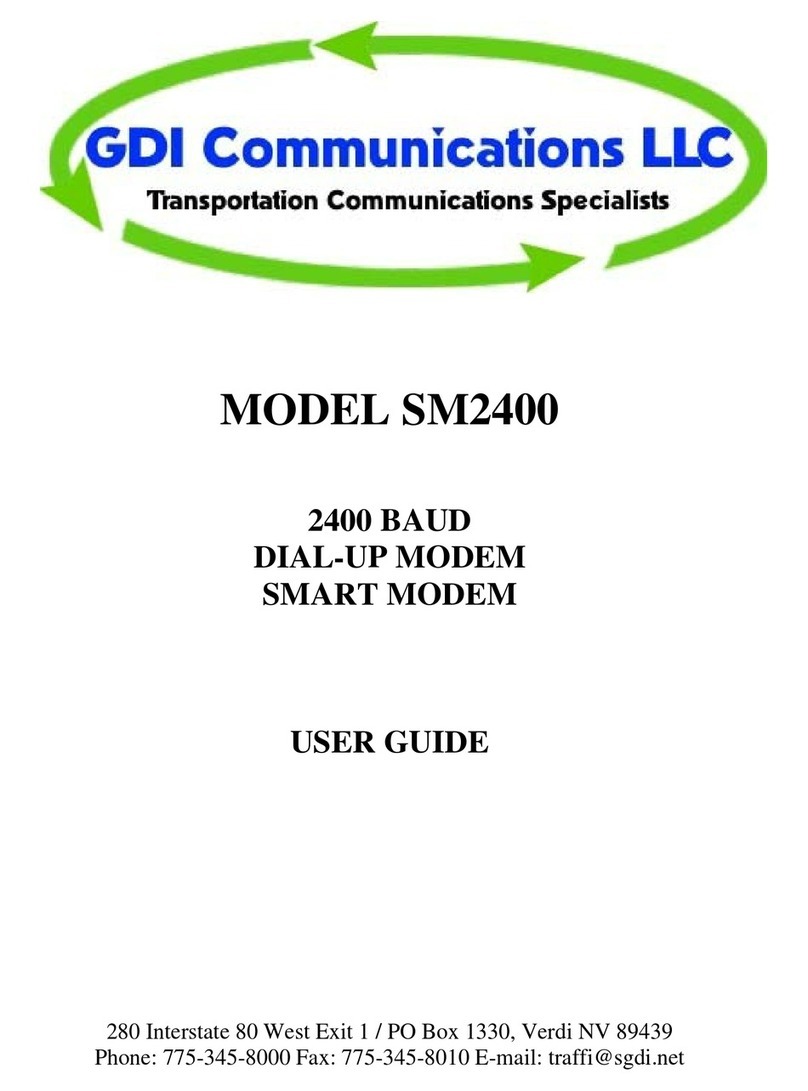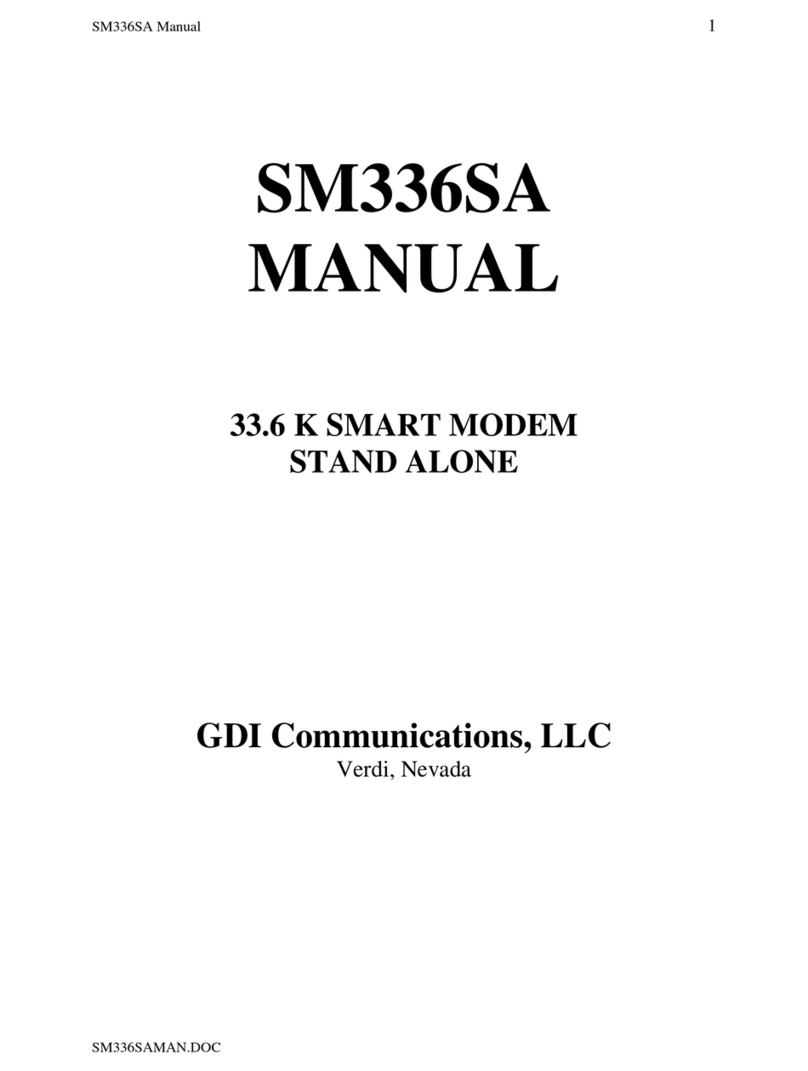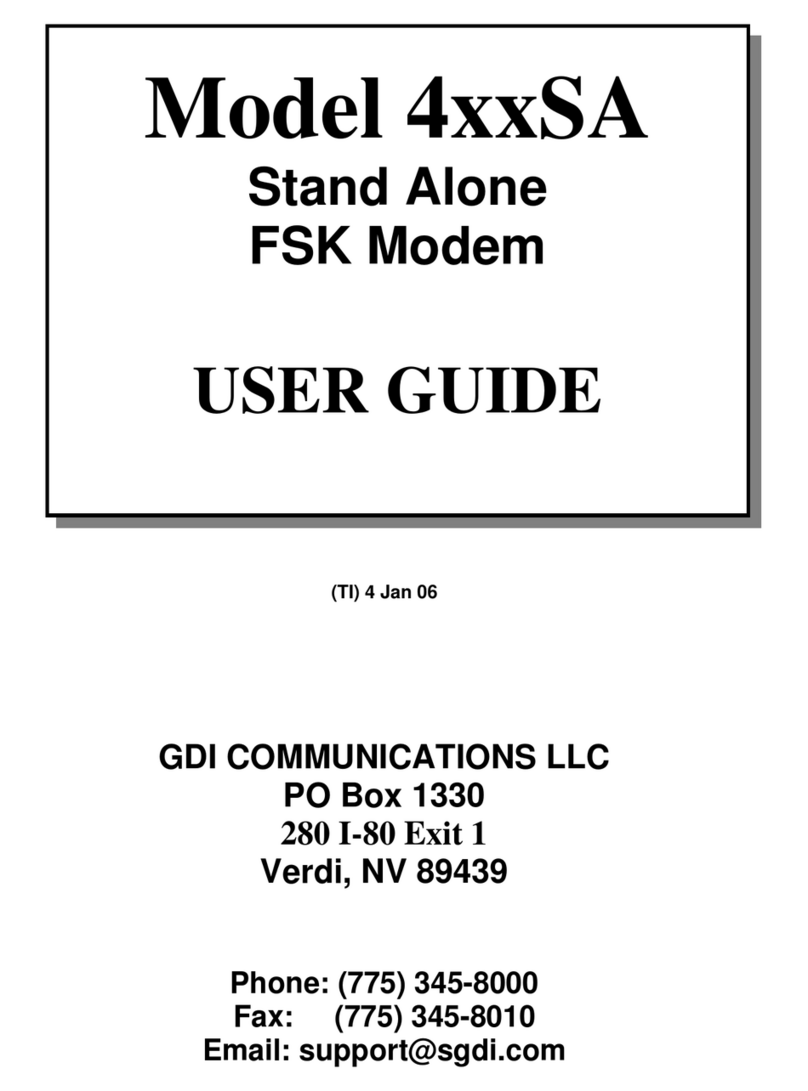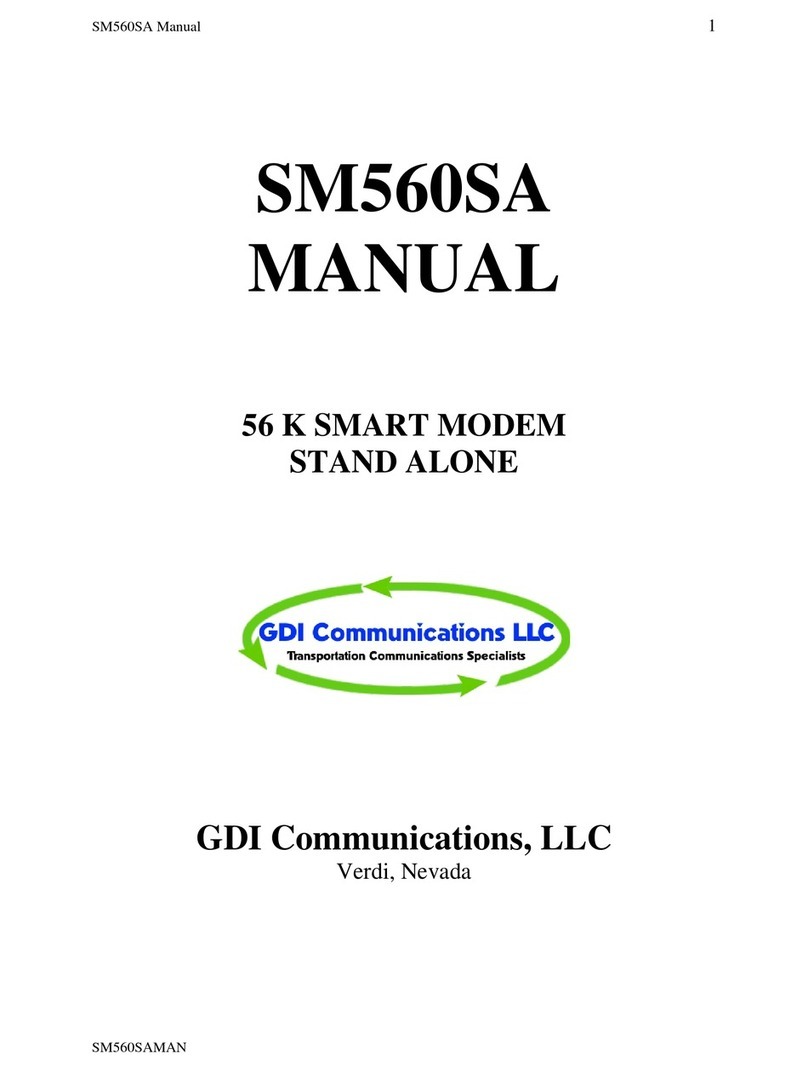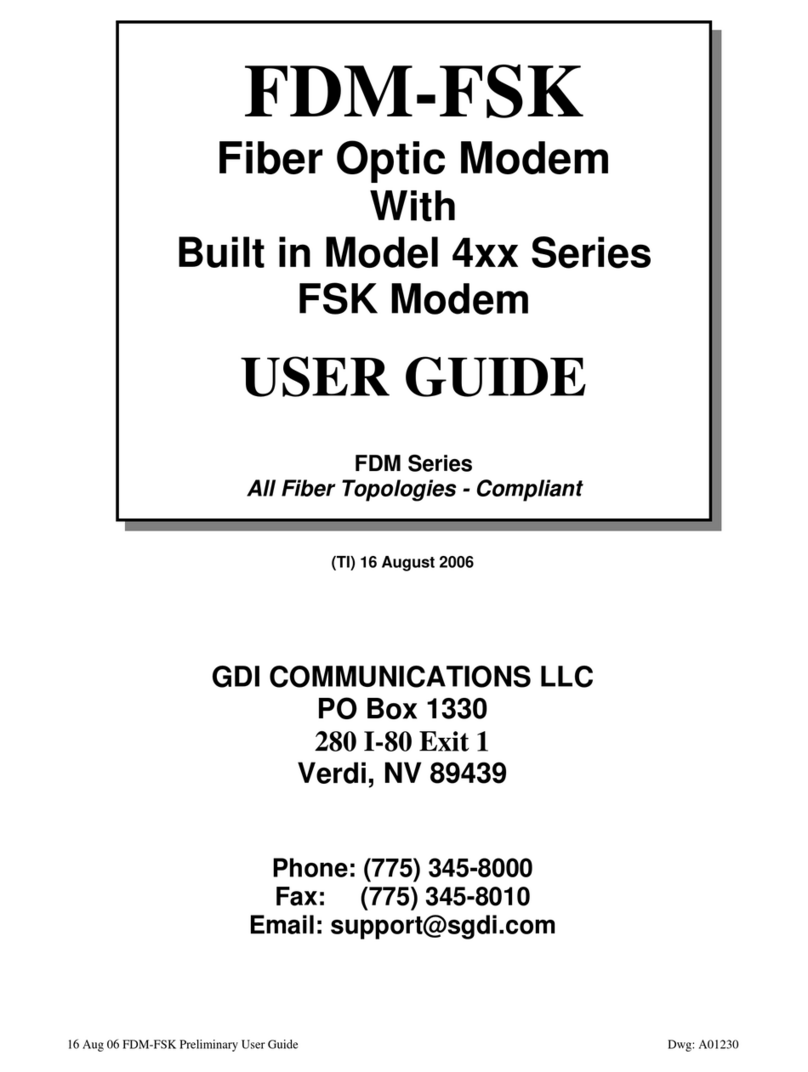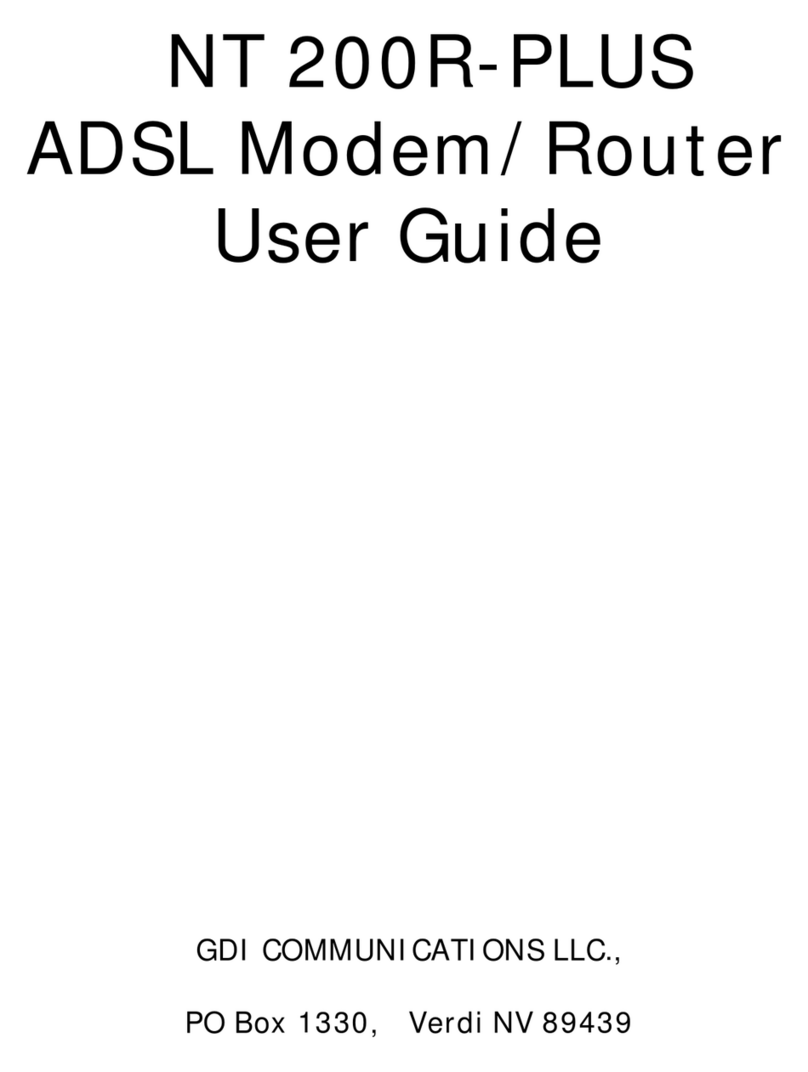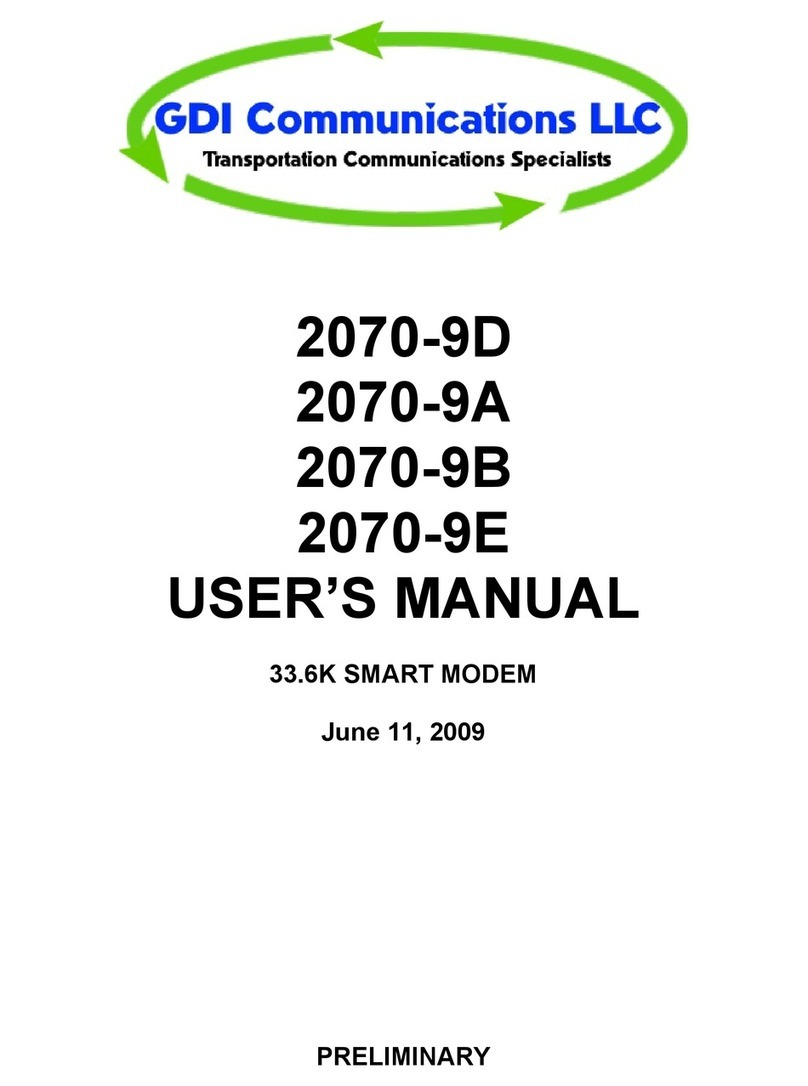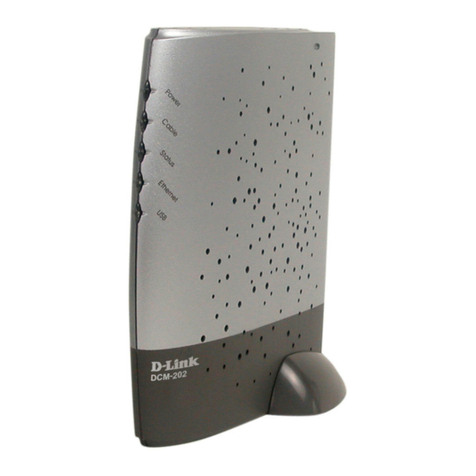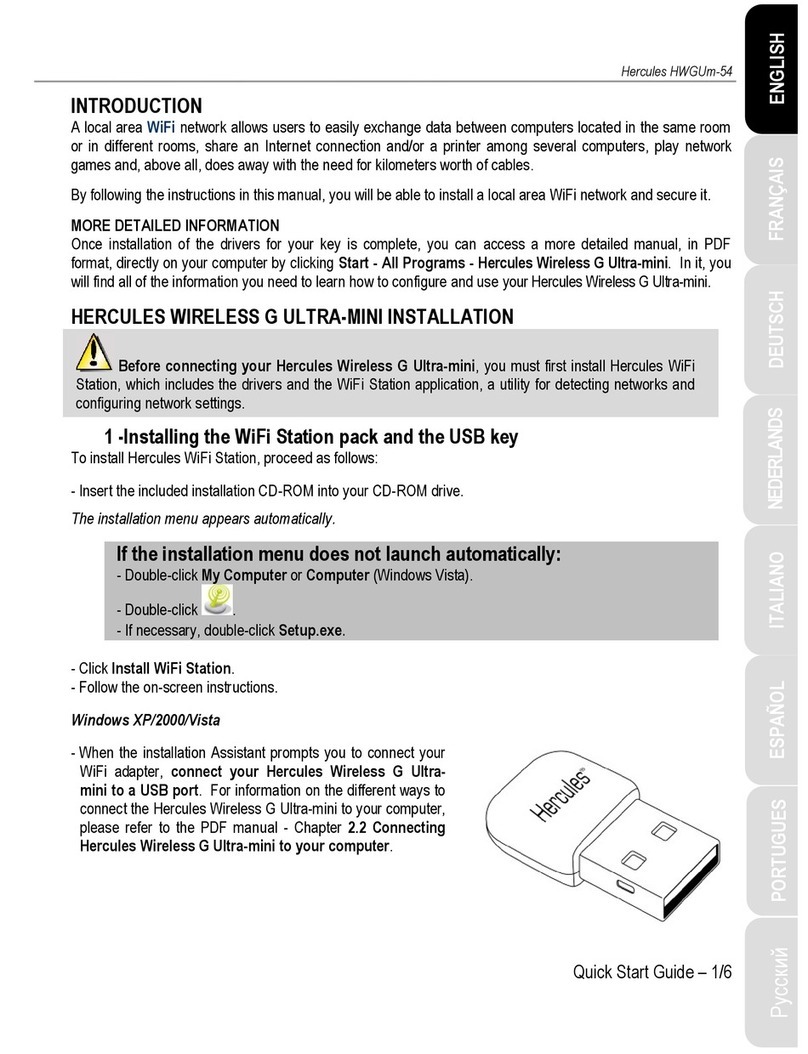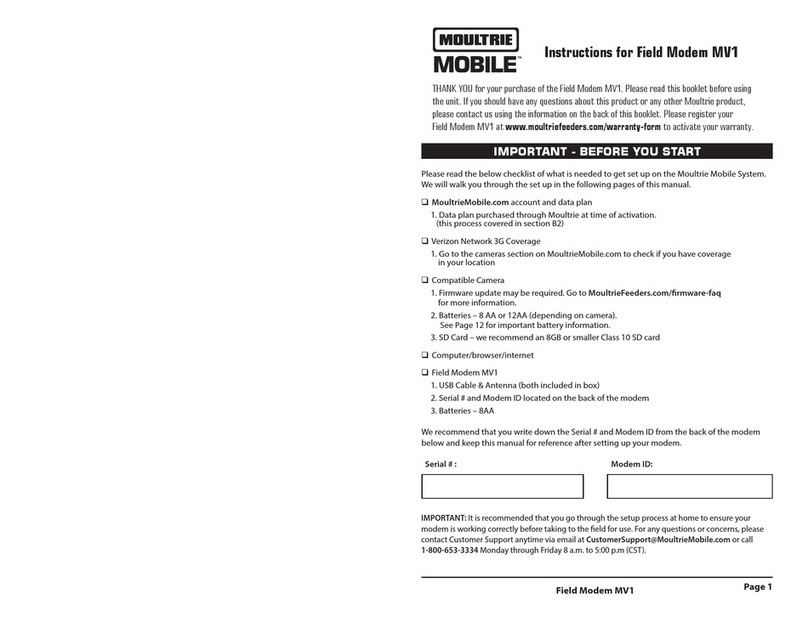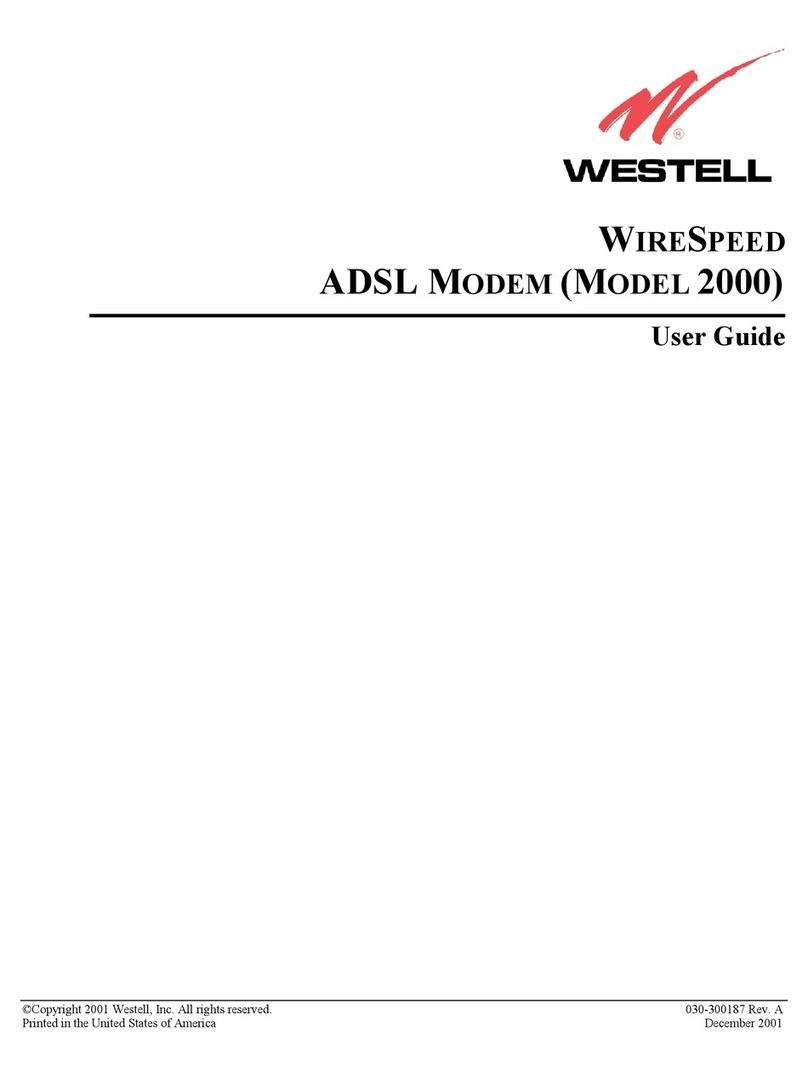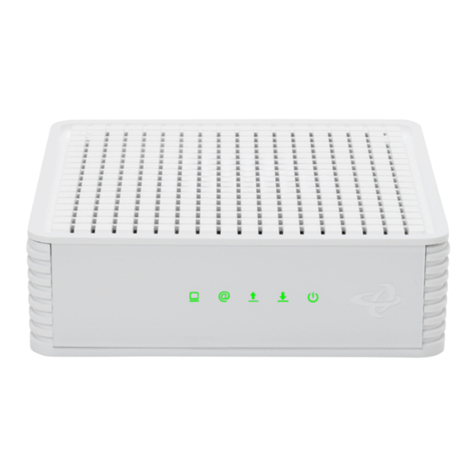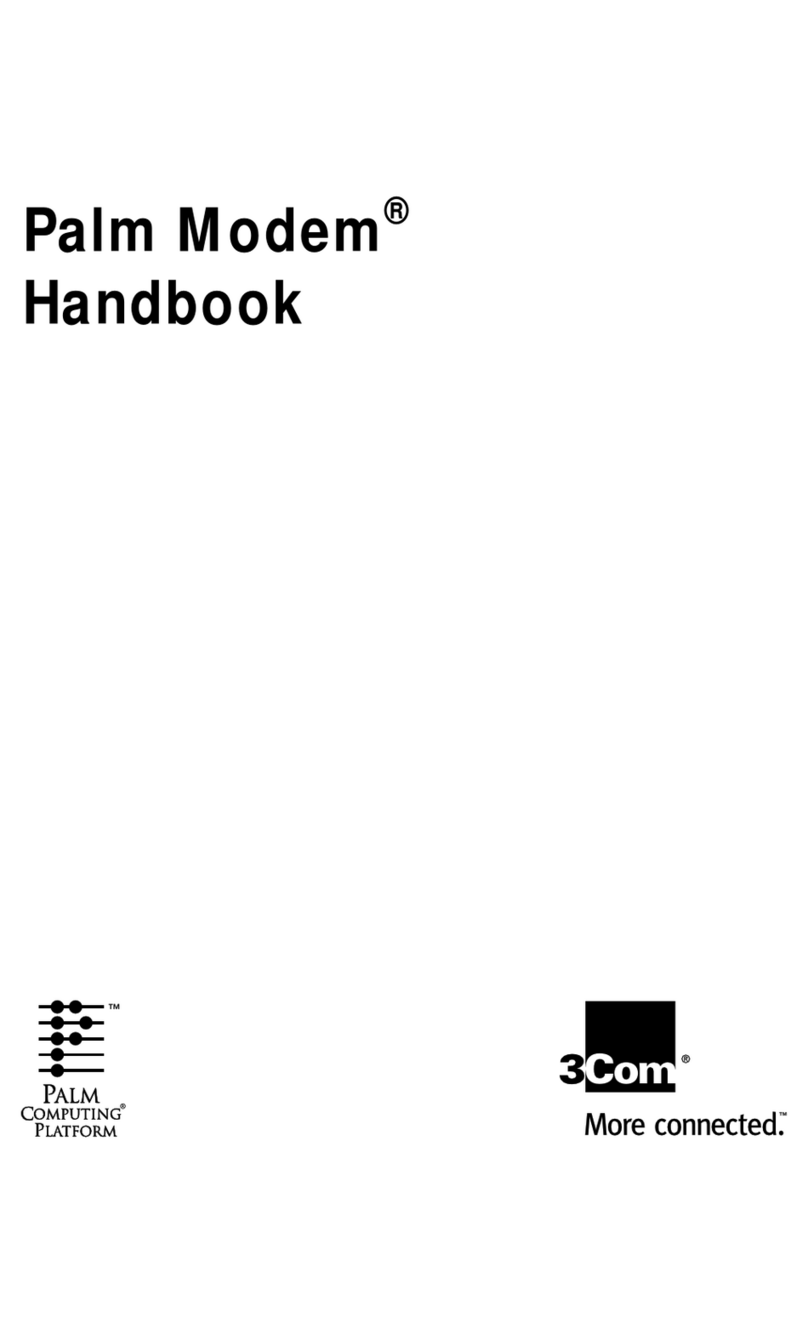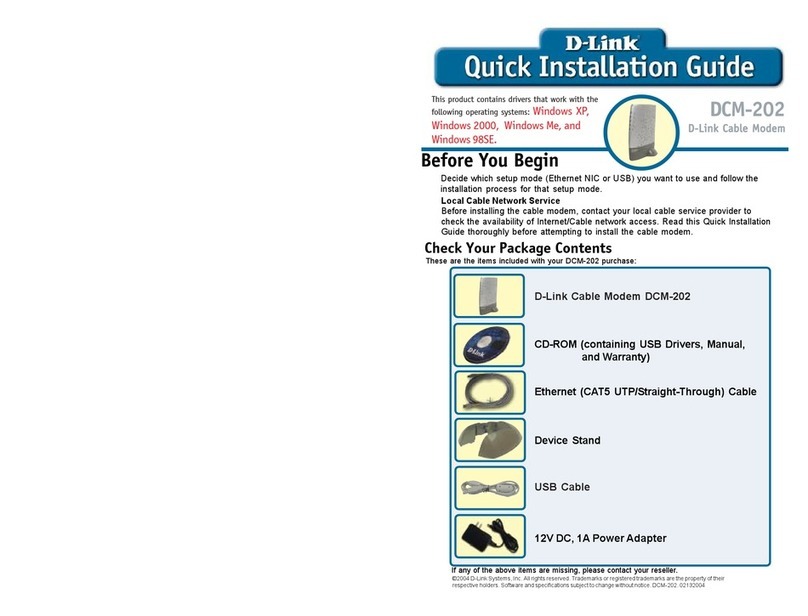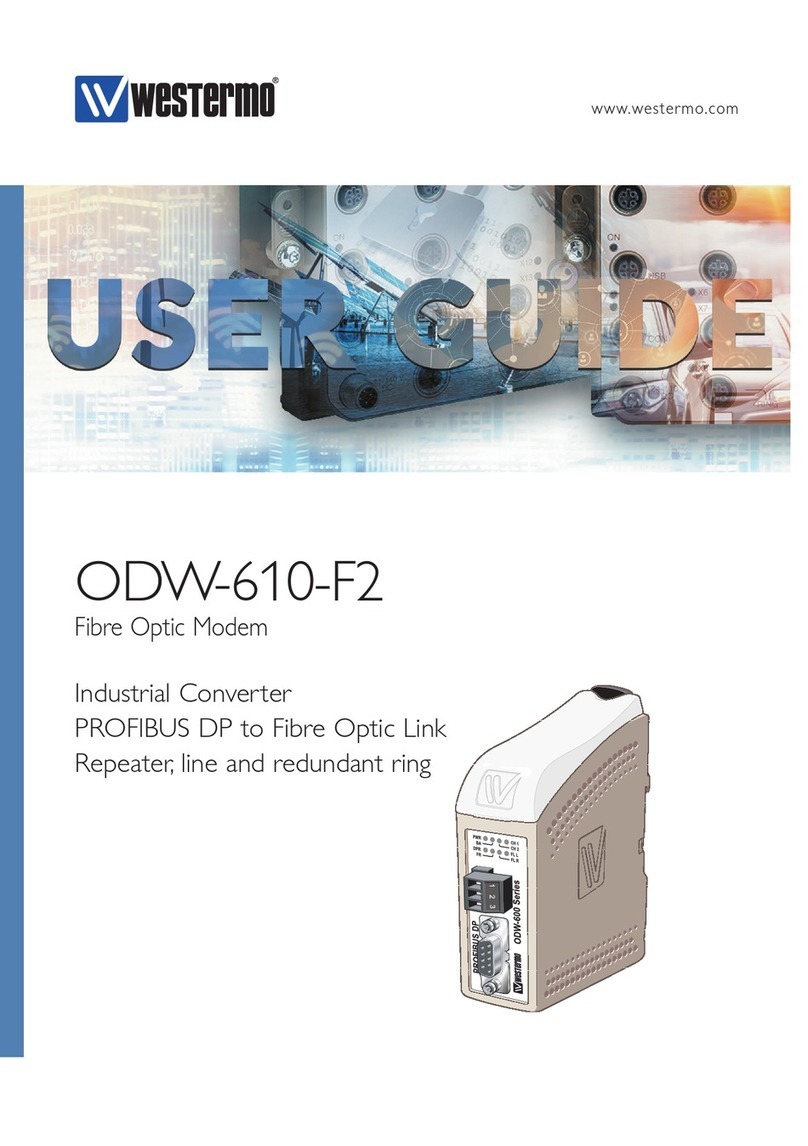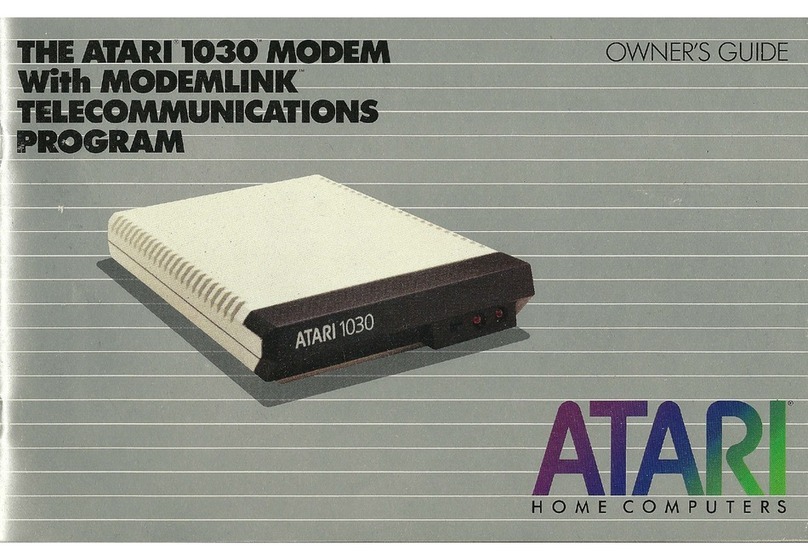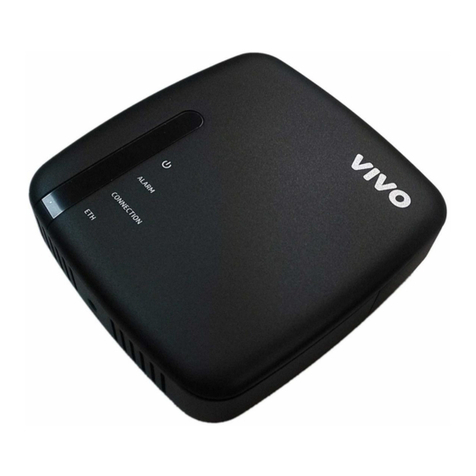GDI SS900FH series User manual

PRELIMINARY
SS900FH
User Guide
Preliminary
GDI COMMUNICATIONS, L.L.C.
SPARKS, NEVADA

PRELIMINARY

PRELIMINARY
GDI
Communications
, L.L.C.
TRAFFIC ELECTRONICS MANUAFACTURER
♦
SPECIALI ING IN COMMUNICATIONS
879 Deming Way
SPARKS, NEVADA 89431
TELEPHONE: (775) 345-8000 FAX: (775) 345-8010

PRELIMINARY

GDI Communications Inc. LLC
PRELIMINARY
PROPRIETARY DATA
This document contains confidential, proprietary data with all
rights and titles reserved by GDI Communications LLC. By
accepting this document, the recipient assumes custody hereof
and agrees not to disclose this data or any portion of this data to
any unauthorized person without the prior written consent of
GDI Communications LLC. Recipient further agrees not to
incorporate these drawings, specifications or technical
information, in whole or in part, in any other product or
endeavor.
THIS LEGEND SHALL BE INCLUDED ON ANY
REPRODUCTION OF THIS DOCUMENT

GDI Communications Inc. LLC
PRELIMINARY

GDI Communications Inc. LLC
PRELIMINARY
SS900FH User Guide
REVISION A
9 14 2007
GDI COMMUNICATIONS, L.L.C.
879 Deming Way
SPARKS, NEVADA 89431
775 345 8000

GDI Communications Inc. LLC
PRELIMINARY

GDI Communications Inc. LLC
TABLE OF CONTENTS
Introduction ................................................................................................................................................................1
Unpacking the SS900FH........................................................................................................................................2
Configuration Switches..........................................................................................................................................2
Host/Controller Connections:.................................................................................................................................2
How to Hook it up:.................................................................................................................................................3
How to configure the SS900FH .................................................................................................................................5
Terminal Settings:..................................................................................................................................................5
Switching the SS900FH to Command mode..........................................................................................................5
Configuration Tag..................................................................................................................................................6
Changing the Communications Settings ................................................................................................................7
Factory Defaults.................................................................................................................................................7
RS232 Communication:.....................................................................................................................................7
RF Communication:...........................................................................................................................................7
Adjusting Performance: .........................................................................................................................................8
Transmit Packet Thresholds: .............................................................................................................................8
Transmit Packet Handling .................................................................................................................................8
APPLICATIONS........................................................................................................................................................9
Point to Point........................................................................................................................................................11
Point to Multi-Point .............................................................................................................................................12
Setting up a Repeater ...........................................................................................................................................13
Repeater topology overview ............................................................................................................................13
Basic Broadcast Repeater Network .................................................................................................................14
Basic Addressed Repeater Network ................................................................................................................15
Indicators..............................................................................................................................................................16
Agency Certifications...............................................................................................................................................17
FCC Certification.................................................................................................................................................17
FCC Notices.........................................................................................................................................................17
Part 15 certification..............................................................................................................................................17
FCC Approved Antennas .....................................................................................................................................17
IC (Industry Canada) Certification.......................................................................................................................17
Appendix A - Command List............................................................................................................................18
Appendix B - Specifications .................................................................................................................................20
Appendix C - Hardwire Reset Factory Defaults ...................................................................................................22
Appendix D - Hyperterminal Program..............................................................................................................23
Appendix E - How to install the GDI SS900FH Configuration Program.............................................................25
GDI SS900FH Config Overview .........................................................................................................................25
“PC Settings” Tab............................................................................................................................................25
“Terminal” Tab................................................................................................................................................26
“Range Test” Tab ...........................................................................................................................................26
“Modem Configuration” Tab..........................................................................................................................27
Displaying the received signal strength ...............................................................................................................29

GDI Communications Inc. LLC

GDI Communications Inc. LLC
1
Introduction
The GDI SS900FH series of wireless modems employ a frequency hopping spread spectrum system (FHSS)
integrated with selectable RS232, 485, 422 devices. The most common type is RS 232, and it is the one referred
to in this manual. It is assumed that the user has a basic understanding of serial RS232 communication principles.
The frequency hopping spread spectrum system is implemented in the SS900FH via a method of transmitting the
traffic communications information within the ISM 900 MHz frequency band .
The RF carrier is switched between 50 distinct frequencies between 902Mhz and 928MHz. This switching
sequence which is referred to as the “Hop Pattern” is pseudorandom to minimize the chance of interference with
other wireless systems. To further isolate different networks, the SS900FH can be configured to 10 different Hop
Patterns
The SS900FH unit is a Data Communications Equipment (DCE) device, ready to be connected to a Data
Termination Equipment (DTE) device via a 9-pin D serial cable, or a USB to 9-pin D serial cable..
This method of implementing a FHSS communication system helps to mitigate the most significant challenges to
all radio communication systems. Namely, interference causes by other transmitters, multipath interference,
interception and jamming, and noise associated with nearby transmitters. The result is a frequency hopping
spread spectrum transmission system that is affordable, reliable, with a high data throughput rate. The GDI
SS900FH system is:
1. Highly resistant to noise and interference. The process of re-collecting a spread signal
statistically spreads out the noise and interference thereby causing them to recede into the
background.
2. The FHSS signals are difficult to intercept. A FHSS signal sounds like a momentary noise
burst or a temporary increase in the background noise to a narrowband receiver.
3. The GDI SS900FH can share the unlicensed frequency band with many types of conventional
transmission systems with minimal interference. This is due to the statistical nature of the
FHSS system, and the power limiting requirements of Part 15 unlicensed devices.

GDI Communications Inc. LLC
2
Unpacking the SS900FH
Figure 1 Contents of the SS900FH package
The package contains the following: 1- SS900FH, 1 - 18VDC Power Supply, 1- Manual and 1 Quick Start Guide.
If ordered, there will be the reverse polarity SMA connector antenna.
For antenna and power options please contact GDI Communications Technical Support.
Configuration Switches
As of the printing of this document, 232/422 is the only switch that is operational. All other switches are
non-functioning.
Host/Controller Connections:
The SS900FH comes from the factory configured for 9600 baud, 8 data bits, no parity and 1 stop bit.
Other configurations can be programmed using either a terminal emulation program or the “GDI SS900FH.exe”
program. Host/Controller connection is made through the DB9 connector located on the rear panel.
OFF
SPARE 2 ON
OFF
SPARE 1 ON
13.3MS
6.6MS
KOD EN
KOD OFF
OFF
6
5
4
3
2
OFF
1
422
232
HD
FD
CONTRO

GDI Communications Inc. LLC
3
How to Hook it up:
Connect a communications cable between the “Main” port on the SS900FH and the host/controller.
Host/Controller* SS900FH
Signal DB9-DB25-C20 Direction DB9
DCD 1-8-H <-------------- 1
RXD 2-3-L <-------------< 2
TXD 3-2-K --------------> 3
SGND
5-7-N --------------- 5
RTS 7-4-J --------------> 7
CTS 8-5-M <-------------- 8
Figure 2 Host/Controller RS-2 2 cable termination
Host/Controller* SS900FH
Signal DB9 Direction DB9
TXD+ 1 -------------->
7
TXD- 2 -------------->
3
RXD+ 3 <--------------
8
RXD- 4 <--------------
2
SGND
7 --------------- 5
Figure Host/Controller RS-422 cable termination
*The indicated Host/Controller pin numbers are for standard terminations and are not accurate
for all devices.
Connect a 900Mhz 50
Ω
antenna via a reverse polarity SMA female connector.
Connect the +18vdc power source via the VDC plug on the rear of the SS900FH.

GDI Communications Inc. LLC
4
Power up the Host/Controller.
Power up the SS900FH.
Figure 4 Connecting a DTE device to the SS900FH (DCE) radio.

GDI Communications Inc. LLC
5
How to configure the SS900FH
The SS900FH operates in two modes:
Normal Mode - In normal mode the SS900FH transfers data between the Main/Aux ports and the RF port.
Command Mode - In the “Command” mode, the SS900FH accepts configuration commands from an attached
terminal or terminal emulation program.
To switch the SS900FH to command mode and configure it, a terminal must be connected to the Main/Aux port
(see figure 4). The terminal can be a real terminal or a PC running a terminal emulation program such as the
Hyperterminal program (supplied with most PCs). See Appendix D for information about creating a
Hyperterminal.
Terminal Settings:
(The following setups can be accessed in the “File->Properties” menu of the Hyperterminal.)
ASCII Setup:
Echo typed characters locally = on
Append line feeds
Port Settings
Bits per second – 9600
Data Bits – 8
Parity – None
Stop Bits – 1
Flow Control – None
OK/Apply
Switching the SS900FH to Command mode...
In the Hyper-terminal window type “+++” without pushing the enter key.
After 1 second the SS900FH should respond with “OK.”
Immediately adjust the time period of inactivity (no valid commands received) after which the SS900FH
automatically exits from Command Mode and returns to normal mode.
Enter ATCT = bb8 (Set the inactivity timer to 5 minutes)
(The TXD and RXD LEDs should flash when communications is established.)
If the “OK” code is not returned then try changing the hyperterminals’s baud rate and parity until the
SS900FH returns the “OK” code.
To reset the SS900FH to the last saved configuration, depress the “Reset” button on the bottom for 2 seconds.
If all else fails, reset the SS900FH to factory default settings. See Appendix C for instruction of how to do
this.

GDI Communications Inc. LLC
6
Configuration Tag
It is recommended that when a new SS900FH is unpackaged, the following information is recorded for future
reference.
GDI SS900FH Identification / Settings.
Serial Number on the back of the SS900FH ___________
Firmware Version (ATVL) ___________
Electronic Serial Number (ATSH)-(ATSL) ___________-___________
Hardware Version (ATHV) ___________
Modem ID (ATID) ___________
Hopping Pattern (ATHP) ____
Destination Address (ATDT) ________
Source Address ________
Address Mask (ATMK) ________
Packet Delivery Retry (ATRR) ________
Pseudo Random Retry Delay (ATRN) ________
Mode (ATMD) ________
Baud (ATBD) ____
(0=1200, 1=2400, 3=9600, 4=19200)
Parity (ATNB) ____
(0=none, 1=even, 2=odd)
Stop Bits (ATSB) ____
(0=1, 1=2)
Transmit Power Level (ATPL) ____DB
( 0=1mw, 1=10mw, 2=100mw,
3=500mw, 4 = 1w)
RF Data Rate (ATBR) ____bps
(0=9600, 1=115200)

GDI Communications Inc. LLC
7
Changing the Communications Settings
Table 1 lists the default communication settings. If you inadvertently change a setting and either lock up the
device or loose communication with it you can reset the SS900FH system to the last saved configuration by
pressing the recessed reset button on the bottom of the unit for 2 seconds or, if necessary return the SS900FH to
Factory defaults by following the instructions in Appendix C.
Factory Defaults
RS 232 SETTINGS Factory Default
Baud Rate (BD) 9600 BPS
Data Bits () 8
Parity (NB) None
Stop Bits (SB) 1
RECEIVE RETRIES (RR) 0
PACKETI ATION THRESHOLD (RB) 80 bytes
PACKETI ATION TIMEOUT (RO) 1 byte of silence.
MAXIMUM RF PACKET SI E (PK) 100 byes
HOPPING CHANNEL (HP) 0
RF DATA RATE (BR) 115200
TRANSMIT POWER 1w
Table 1 - Default Settings.
After all setups have been configured,
use ATWR to save the configuration to NVRAM, &
use ATCN to Exit Command Mode
RS2 2 Communication:
Baud Rate: ATBD = x
x = (0=1200, 1= 2400, 2= 4800, =9600,4=19200, 5= 8400, 6=57600, 7=115200, 8=2 0400)
Parity ATNB = x (0=none, 1=even, 2=odd, =mark, 4=space)
Stop Bits ATSB = x (0=1, 1=2)
RF Communication:
Hopping Sequence: ATHP = x (x = 0 through 9)
RF Data Rate ATBR = x (0=9600, 1=115200)
RF Transmit Power ATP = x (0=1mw, 1=10mw, 2 = 100mw, = 500mw, 4 = 1w)

GDI Communications Inc. LLC
8
Adjusting Performance:
After all setups have been configured,
use ATWR to save the configuration to NVRAM, &
use ATCN to Exit Command Mode
Transmit Packet Thresholds:
Use these commands to adjust the data packets size to match the application. The default values should
work with most applications. However, they can be adjusted to improve performance.
Packetization Threshold ATRB = x (0-PK) Default = 80
Set/read character threshold. RF transmission is begun after receiving RB bytes, or after receiving at
least 1 byte and seeing RO character times of silence on the UART.
Packetization Timeout ATRO = x (0-0xFFFF) Default = 1
RF transmission begins after receiving RB bytes, or after receiving at least 1 byte and seeing RO
character times of silence on the UART. If RO=0, then RB bytes must be received before beginning
transmission.
Maximum RF Packet Size ATPK = x (0-0x800) Default = 100
Set/read maximum RF packet size. Must be 256 (0x100) or less for 9600 baud RF rate (BR=0), and 2048
(0x800) or less for 115200 baud RF rate (BR=1).
ATWR <Enter> OK (Write the new values to NVRAM)
ATCN <Enter> OK (Exit command mode and return to normal operation)
Transmit Packet Handling
Retries: ATRR = x (x = 0-0xFF) Default = 0
Set/read maximum number of RF packet delivery attempts. If RR is non-zero and MT is zero, packets
sent from SS900FH will request an acknowledgement, and will be resent up to RR times if no
acknowledgements are received.
Multiple-Transmit ATMT = x (0-0xFF) Default = 0
Set/read number or retransmissions. If MT parameter is a non-zero value, RR is ignored and all packets
are sent MT+1 times, without any delay between the transmissions.
Delay Slots ATRN = x (0-0xFF) Default = 0
Set/read the maximum number of delay slots used for random back-off algorithm after transmission
failure. A delay slot is 5 msec @ BR=1 and 54 msec @ BR=0.
Streaming Limit ATTT = x (0-0xFFFF) Default = 0
Set/read maximum number of continuous bytes transmitted by one module before forcing a delay that
allow other modules to transmit. 0 = disabled.

GDI Communications Inc. LLC
9
APP ICATIONS
The following configurations are adjusted for optimum performance in a traffic communications network where
there is one Master/Local controller that initiates communications with Slave/Remote controllers. The SS900FH
provides the means for these controllers to communicate with each other over wireless networks.
GDI recommends that a site survey be performed before any installation of wireless modems. The survey
includes but is not limited to, Line-Of-Sight determination, Fresnel one calculations, and a spectrum analysis of
the area.
The Line-Of-Sight will determine the best placement of the antennas.
The fresnel zone calculations will determine antenna height .
The spectrum analysis will determine if there are any interfering signals in the area.
The SS900FH uses data Packetization for transmitting and receiving data. The SS900FH collects serial data from
the source controller until either the Packetization Threshold (RB) is reached or one byte followed by
Packetization Timeouts (RO) of silence is detected. After which the SS900FH transmits the packet.
The transmitted data packet contains not only the data collected from the controller but also ID and addressing
information which insulates the SS900FH network from other devices operating in the same area.
Each receiver performs the following process when a
packet is received.
Packet recognition is the process by which the
SS900FH either accepts or rejects a data packet.
ID – All modems in a network must have the same ID
because SS900FH rejects any packet if it does not
have the same ID. On the other hand the ID
parameter can be used to isolate different
networks.
Figure 5 Packet Recognition

GDI Communications Inc. LLC
10
Source Address (MY), Destination Address (DT), and Mask work according to the following diagram.
Figure 6 Address Recognition
TX_DT = Destination Address of transmitting modem
RX_DT = Destination Address of receiving modem
RX_MK = Address Mask of receiving modem
RX_MY = Source Address of receiving modem
Table of contents
Other GDI Modem manuals
Popular Modem manuals by other brands

HomeSpot
HomeSpot HS-WIFIUSB Quick install guide

General DataComm
General DataComm Quester III V.90 quick start guide

Paradyne
Paradyne FrameSaver FLEX 9123 user guide

ViaSat
ViaSat surfbeam SM-1000 user guide
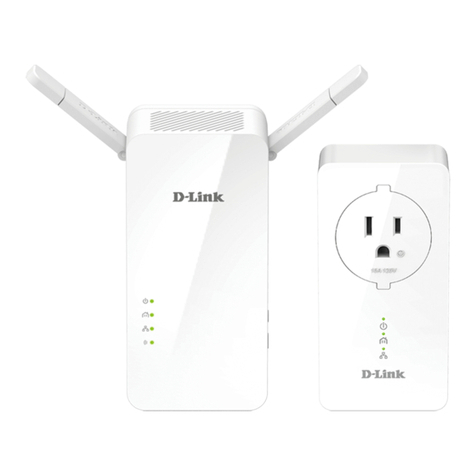
D-Link
D-Link PowerLine DHP-W611AV Quick installation guide
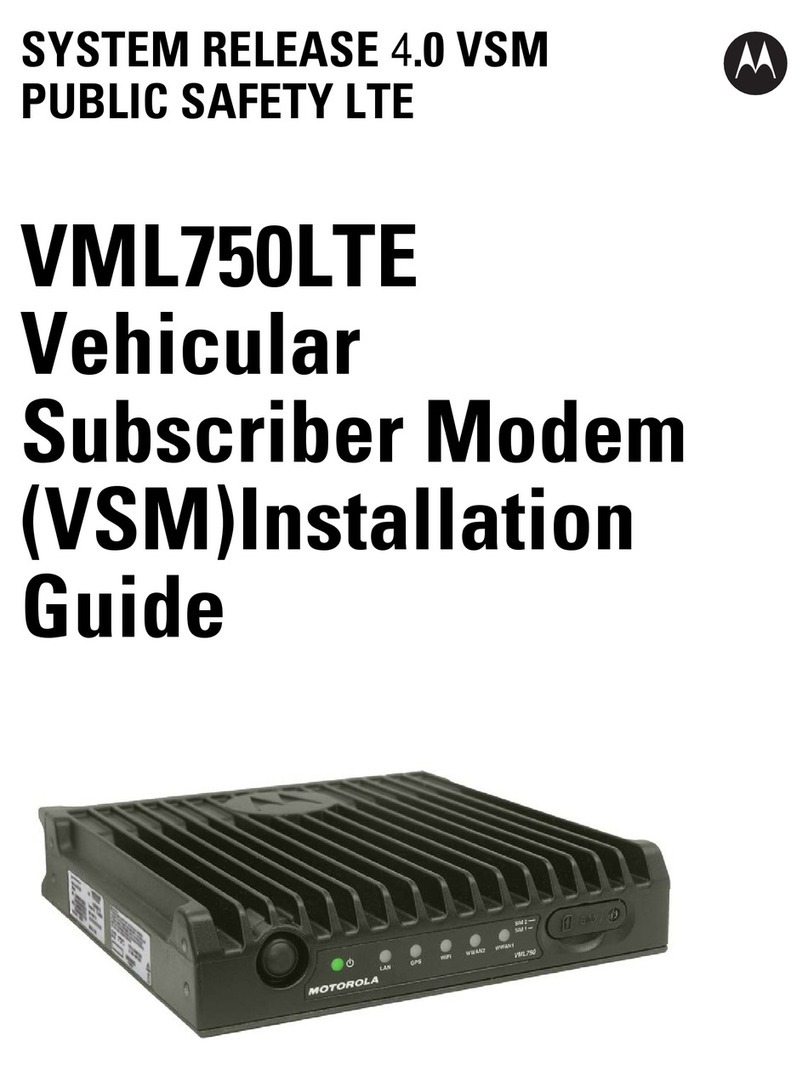
Motorola
Motorola VML750 installation guide
